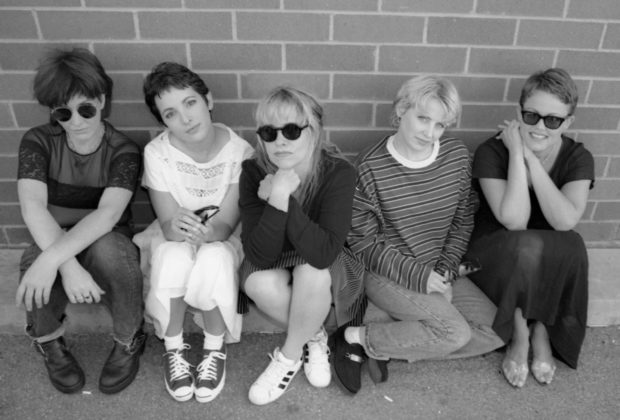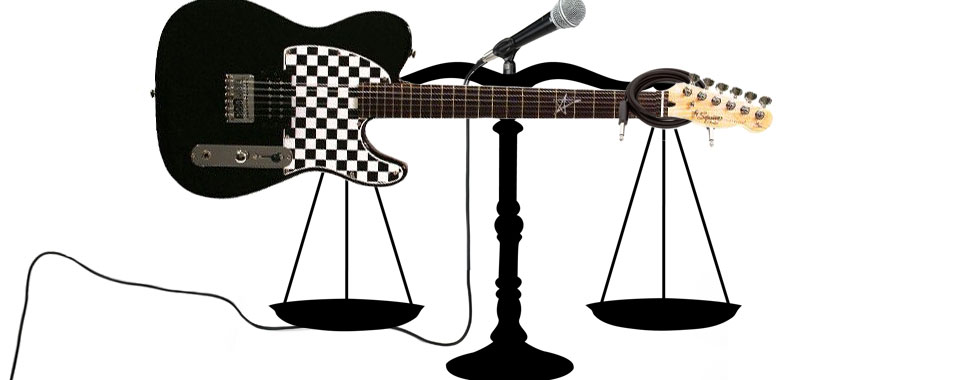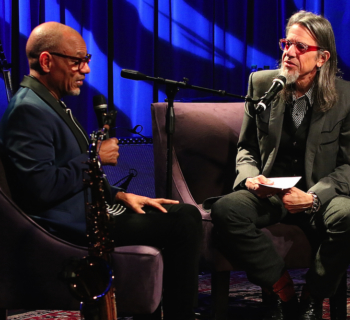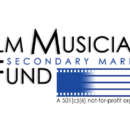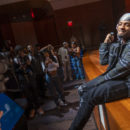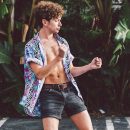Multi-platinum Los Angeles rock band the Go-Go’s, featuring Charlotte Caffey, Belinda Carlisle, Gina Schock, Kathy Valentine and Jane Wiedlin, will see the release of the Alison Ellwood-directed THE GO-GO’S on DVD and Blu-ray formats (Polygram/UMe) February 26, 2021, and through digital download & rental services (Eagle Rock Entertainment) on February 5, 2021.
The documentary debuted in the summer of 2020 on Showtime cable television. The film was done in association with Showtime, Polygram Entertainment, Universal Music Publishing Group and Interscope Films a Fine Point Films and Fadoo Production.
THE GO-GO’S
CHARLOTTE CAFFEY (Lead Guitar, Keyboards, Vocals)
BELINDA CARLISLE (Lead Vocals)
GINA SCHOCK (Drums, Percussion, Vocals)
KATHY VALENTINE (Bass Guitar, Vocals)
JANE WIEDLIN (Guitar, Vocals)
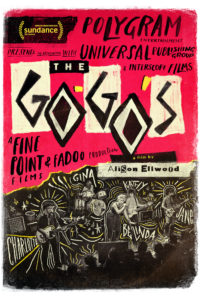
The Go-Go's Cover Art
Ellwood’s THE GO-GO’S documentary, which first premiered at the prestigious Sundance Film Festival won a 2020 Critics Choice Award for “Best Music Documentary” in addition to receiving the honor of “Most Compelling Living Subjects in a Documentary.”
During 2020 reviewers in newspapers and radio stations have praised the endeavor.
“A treasure trove of archival footage that thoroughly excavates the group’s early punk bona fides.” – NEW YORK TIMES
“A laudably forthright, well-researched and perceptive testament to the power of pop music.” – NPR
“They created their own space in a male-dominated corner of the music world – in their case, the rough-and-ready LA punk scene, where they formed in 1978 – and transcended it with a mix of sisterhood, spirit and irrepressible pop songs.” – BBC.
The candid and archive-rich documentary assesses the group’s place in music history and offers full access to the Go-Go’s. With their roots in the LA punk scene, this film is a serious appraisal of their story and sets the record straight about their historical ascent to global stardom.
One moment of the film focuses on their recent collaborative efforts in writing a new song, a female empowerment statement, “Club Zero,” which became the first Go-Go’s single in nearly 20 years and hit the Top 10 on the Rock Digital Song Sales chart.
The Go-Go’s skyrocketed to superstardom after they released one of the most successful debut albums of all time, 1981’s Beauty And The Beat, a collection of hook-laden, infectious songs that stayed at No. 1 on the Billboard charts for six consecutive weeks, spawning the hits “Our Lips Are Sealed” and “We Got The Beat” and also earned them a Grammy nomination for “Best New Artist.”
Their 1982 follow-up, Vacation, hit Top Ten on the Billboard 200 featuring the track “Vacation.” The Go-Go’s have sold over 7 million records worldwide and earned the notable distinction of being the only all-female band to write their own songs and play their own instruments on a No. 1 album.
The Go-Go’s will be honored at the Women’s International Music Network Jan. 22, 2021 She Rocks Awards, which pays tribute to women in the industry.
In June 2021, the Go-Go’s are scheduled to perform a series of summer North American tour dates.
Greg Franco, Bandleader of Rough Church and Man’s Body: “Critics diminish the Go-Go’s contribution to rock and roll as a 2-hit wonder LA bubblegum band.
“However, I saw them not only as the coolest chicks ever, but worthy of rock and roll respect. These women were no wallflowers. They inspired me; I wanted to get up on stage, sing and sweat, and perfect the band sound too.
“Rodney Bingenheimer and his Rodney On The ROQ weekly radio show in Pasadena California first introduced me and the world to the Go-Go’s.
“The Go-Go’s invaded a smelly frat house; in 1976 Rodney showed up on Saturday nights with hot chicks and badass records and demos. It was only then that the music on the air became as young and vibrant as its audience. Later Rick Carroll, as program director, made this music a successful programming template.
“In 1980-81 KROQ-FM was a great station to listen to. Rodney broke the Go-Go’s, playing their demo cover of the Shangri-La’s song 'Walking in the Sand.’ He also played Blondie and the Ramones for the first time in LA. The station went from being a barely heard squeak in the FM radio universe to being a hot to tune in station. It was working, and KROQ was becoming a legitimate cultural weapon of its time. The Go-Go’s were the soundtrack a generation of kids. They were surfing punk and new wave along with the Specials, X, and the Cramps.
“After hearing the Go-Go’s on KROQ and LOVING the first single, I went to Pooh-Bah Records in Pasadena to grab their Stiff Records release ‘We Got The Beat/How Much More.’ Chicks and dudes alike, we dug it. It was our music.
“Soon would come the MTV era, which changed the entire game in a way that helped kill the party. In retrospect, I can see more clearly the cultural impact the Go-Go’s had on my Burbank High Schools days. We watched locals conquer the world for a moment. Knowing that they were LA gals who were like us, the record collectors, the thrift store clothes buyers; these newly minted musicians were also dodging the slings and arrows of the music biz, and that also inspired us.
“I see the Go-Go’s in the realm of some of the great groups. They were very influential at a time when the vintage was sweet, the grapes just perfect. Were you in LA in 1976-81? It's not at all a bad era for music. The Go-Go's reside in that equation.”
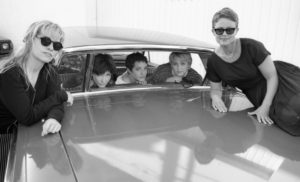
Credit: Vicki Berndt
Gary Pig Gold, Writer and Musician: "Perhaps always just as much, if not more, Fanny or even Ace of Cups than Runaways, the Go-Go's brought a much-needed sense of Bye Bye Birdie as opposed to Apocalypse Now to the fledgling Hollywood p-rock scene," schemes Guy of 100 Lists Gary Pig Gold.
"Realizing right away to associate and/or surround themselves with only the coolest of past masters – various Sparks, Specials, Police, Ventures, and most crucially sixth Go-Go Richard Gottehrer – this was one band who housed musical chops (Caffey), song-writing smarts (Wiedlin), a superb rhythmic section (Valentine and Schock) with an All-American baseball-datin' new age Ann-Margret to front it all.
“While their extra-circular activities could easily rival even those of similarly supposedly clean-cut SoCal Beach Boys, the Go-Go's in fact took their fun seriously enough to rack up platinum long-players, earn their Hall plus Walk of Fame stars, and even inspire a Broadway play alongside a couple'a tell-almost-all tomes. The Stones to the Bangles' Beatles? No... let's just say these were indeed some girls who beat multiple music biz odds with beauty and, yes, brains. God Bless the Go-Go's."
Dr. James Cushing, Writer and Poet: “The Go-Go’s! I can’t remember how many times I heard the Go-Go’s between 1977 and 1983, but it was at least 25, because they were the inevitable opening act for any punk bands at any of the venues across the city — the Hong Kong Cafe, Club 88, the Starwood, Baces Hall, no matter where, the Go-Go’s would be the opening act, cheerfully mugging through ‘We Got the Beat’ and ‘Skidmarks on My Heart’ and the others. They were consistently strong performers who had real songwriting ability, and women told me they felt safe and welcome at Go-Go's shows, in contrast to the more fisticuff-heavy Black Flag / Circle Jerks sort of action. They persisted and they triumphed.
“What do I mean by ‘triumph’? My first Go-Go’s show was at the Masque in (I think) September 1977; they got through two songs in that legendarily crappy basement before the toilet flooded and we all had to split because there was smelly water everywhere. The last time I saw the Go-Go’s was September 1983 — at the Anaheim Stadium, opening for Bowie. They got through the whole set.”
Daniel Weizmann, Writer: “The Go-Gos presented themselves as byproducts of day glo pop art and mod/surf culture, but under the surface I see them as direct descendants of the pre-code Warner Brothers ‘backstager’ musicals--the flicks choreographed by Busby Berkeley and starring Ginger Rogers, Ruby Keeler, Una Merkel and all those other tap-dancing babes in satin hot pants.
“I'm not just talking about a cosmetic connection. The Go-Go’s came off with the wise-cracking spirit of a new kind of 20th century female. Their lyrics, their energy, their attitude is street smart, reckless, and footloose. They aren't just glamorous--they're about the dream of glamour.
“In fact, they describe themselves as dreamers and whores without irony, they openly lament falling in love, they exchange secrets like those 42nd Street chorus girls who know they're the only ones who can save the show.”
Heather Harris, Photographer: They used to be invisible, like pretty Ida Lupino known for her acting but not her directing career. Nowadays not only is there a deserved bevy of film directors of the XX chromosome persuasion, but we also know their names as rightful branding connected to projects: Patty Jenkins, Kathryn Bigelow, Penelope Spheeris, Greta Gerwig, Amy Heckerling, Sofia Coppola et al. (Students of Cinema must add Dorothy Arzner, Agnes Varda, Lina Wertmuller, Jane Campion and [please swallow your cardiac meds before reading the following, but the evil one was probably the greatest of them all, really, then or now,] Leni Reifenstahl.)
“Now the following name will be added without pause to the preceding, documentary director Alison Ellwood. She knows how to navigate overcrowded fields deftly and just cherry pick the best images and factoids to insure her work as the one you remember. Witness her Laurel Canyon, A Place in Time, best of the three documentaries on the lost musical world of Laurel Canyon habitues that were all released more or less at the same time. Ellwood's is the go to one for the most complete history.
“Ellwood's only persistent invisibility is her deft touch. Her newest THE GO-GO’S tackles a topic that some dismissed as frothy angel food cake, and made a treatise on the undercurrent philosophies of Julia Child's The French Chef out of it.
“After all, this was a band of very, very young women who made their own breakthroughs in a competitive field that's tough sledding for everyone, male, female, whatever your diversity. And they succeeded beyond everyone's wildest dreams including their own.
“Her starting base was women who went from loving to hating one another, despite the soothing unguents of newly created wealth. There was also those pesky bootleg private videos of X rated pastimes fueled with once fun drugs that accompanied their time on the charts, about which everybody in the industry knew. (Less successful sister act the Pandoras also had them. Investigate this amazing band with ten times the drama of the Go-Go’s, those who would follow in Ellwood's filmic steps.)
“Alison Ellwood's cool doc THE GO-GO’s released in 2020 may end up the only good thing anyone remembers from this sordid, ailing, disenfranchised and enslaved year. All those projected 2021 tour dates of the reunited Go-Go’s are not going to happen. We are too far gone for the good things in life even in the near future...”
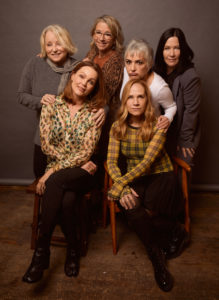
Gina Schock, Belinda Carlisle, Alison Ellwood, Jane Wiedlin, Charlotte Caffey, and Kathy Valentine from The Go-Gos poses for a portrait at the Pizza Hut Lounge 2020 in Park City, Utah. (Photo by Emily Assiran/Getty Images)
Alison Ellwood’s feature film directing credits include American Jihad, History of the Eagles, Parts 1&2, Spring Broke and Magic Trip: Ken Kesey’s Search for a Kool Place.
Her television directing credits list CNN’s Death Row Stories, Locked In for ESPN’s 30 for 30 series, No Limits for ESPN’s Nine for IX series, The Human Behavior Experiments, the Emmy Award-winning series American High, The Travelers and Sixteen.
Ellwood has produced and edited several feature documentary films including Oscar-nominated Enron: The Smartest Guys in the Room, Catching Hell, Gonzo: The Life and Work of Dr. Hunter S. Thompson, My Trip to Al Qaeda, and Casino Jack and the United States of Money.
She was co-producer for the feature documentary Finding Fela and HBO’s Brett Killed Mom: A Sister’s Diary. Ellwood was consulting producer for the Sundance series Brick City and two feature films The September Issue and Food Chains.
Ellwood was supervising producer for The Residents and 30 Days. Ellwood has edited for Bill Moyers Specials, the Discovery Channel, Sundance Channel, Showtime and HBO’s America Undercover series.
In 2013 she directed History of the Eagles, a TV 2 episode mini-series documentary. During 2020 her Laurel Canyon: A Place In Time debuted on the EPIX/MGM TV channel.
Ellwood’s Women of Troy an HBO documentary in 2020 examining the transcendent career of basketball icon Cheryl Miller and her University of Southern California Trojans and their impact on women’s basketball and the first emergence of Title IX’s influence in women’s sports is one of the best films I’ve seen this century.
Harvey Kubernik Interview with Alison Ellwood
HK: You were born in Australia. How did you enter the documentary arena?
AE: It started for me with National Geographic magazine. I was obsessed with it before I could even understand the depths of the articles at 6, 7 and 6 years old. And I wanted to be a photo journalist and my dad got me a camera when I was 8. I started taking pictures. When I was ten I had a dark room which we set up and started developing things. And I just was in love with stories and images. And then I started going to movies as a kid and fell in love with the movies. This is what I want to do somehow. And then I ended up going to film school at New York University and that’s how I got going. Pretty early on that is what I wanted to do.
HK: Do you have a couple of favorite documentaries?
AE: I know it’s not really a documentary, but one of my favorite movies of all time is This Is Spinal Tap. I also love Albert and David Maysles’ Grey Gardens. The characters were fascinating.
HK: How did this directorial job on the Go-Go’s happen?
AE: I got a phone call from Eimhear O'Neill who was one of the producers on the project who I'd known for years. And then I got this very random phone call from the manager of the Go-Go's about directing a film about them. “Are you interested?” And I said, "Great to hear from you. Yes!'
I was always a huge Go-Go's fan, too. I just loved their music and being an all-female band is super cool. And so I was very excited to hear they wanted to do it. I had several phone meetings with the band members. They wanted to make the film but were still a little bit gun-shy after their Behind the Music experience that they felt was very salacious. And they didn't want a repeat of that. We met in person in New York and we went out and had dinner. We completely hit it off and bonded. And then I finally convinced them to go forward with it.
I was never really much of a punk fan, I have to admit. So I didn't really know too much about their punk origins and it was really fascinating for me to learn about all that and to see how they taught themselves to play their instruments, becoming such prolific and talented songwriters. I know Charlotte, Gina and Kathy had musical training, but Belinda and Jane hadn't and neither had Elissa (Bello) or Margot (Olavarria), who were initially in the band.
It was a group of women coming together and deciding, “Hey we can do this too.” And I think that's just such an incredibly powerful message -- especially for young girls.
HK: Let’s talk about your pre-production process?
AE: I get immersed in viewing archive, artifacts and listen to the music. Initially I do an immersive reading of everything I can find on them and listen to the music simultaneously. And then look at archives available, usually online, and then when the project is greenlit then I start getting archive that come in officially then find you start I finding things never seen before or haven't in a long time. And that kind of sparks Ideas. And then once I feel I've looked at enough material, read enough, then we set up doing the Interviews so that they can really be extensive and inclusive of lots of different things.
HK: What is the key to getting a good interview?
AE: I think everyone approaches these things differently but the most important thing that I feel that I’ve learned over the years is to have it be as conversational as possible. And jump around in time a lot. Especially with people that have been interviewed multiple times so they don’t feel they are treading over the same material. You just jump around a bit so questions come and they aren’t expecting them. They will say something that happened in 1981 and I’ll add “how does that relate to your childhood?” And they go back. And it keeps it more conversational.
Obviously, trust is the first key thing. They have to trust you and I have to trust them. That’s what I said to all the girls in the band. I said “You have to trust me because I have to trust you, because I don’t want to make a commercial. I don’t want to do a fluff piece here. So it’s a mutual trust where we have to be honest with one another. And if you are honest with me we will make an honest film.” That’s what I try and do.
HK: Is there another motive to bringing out history and facts that at times are reminders of a comical or dark past?
AE: Again, it all comes down to trust. Sometimes you have to push them a little bit. I was pleasantly surprised how forthcoming they all were in their interviews. I was a little worried they may be a bit hesitant but they all just went there.
“Charlotte has been very public about her drug addiction problems. She wanted to be public about it in order to help other people. They addressed some personal things in the band. I was surprised that Gina mentioned that she and Jane had a relationship. Because I knew that but wasn’t sure she was gonna go there. But she did, which is great.
You know Jane surprised me when she said she was diagnosed as being bi-polar and only Charlotte in the band knew at that point and she didn’t want the others to even know. (laughs). Regarding interviews, keep them kind of off guard in the interviews so they don’t expect what is coming next. ‘Cause it keeps it like I said before more of a conversation and a dialogue and less of a rehash of stuff they’ve already talked about.
HK: Are you influenced by presenting subjects in a chronological manner?
AE: Well, chronology is always a good friend of the way to start something because at least it’s a way of clearly laying out something. But then I think at times it can get in the way.
The first cut on the Go-Go’s was about three hours. And it didn’t make sense to break it up to two films. We wanted it to be a feature. That version was very much a chronological layout with all the funny and crazy stuff that happened to them along the way. Fun gem moments. But you have to realize “what story are we telling here.” We just don’t want to go from one anecdote to another. Because that’s not building a drama here so we then went back and said “what is each character’s arc? What are their story arcs?” And if things didn’t pertain necessary to that we would pull it out whatever scenes we were contemplating and does it work without it?
At one point we tried to break the chronology. And I actually started the film with the band together now, at the Whisky a Go Go, which I thought was a fun and cinematic way to begin. But in the end, it felt like it took away the suspense of them getting back together again. A lot of people think the band broke up. If you don't know them, you might not know that the Go-Go’s have continued to carry on, selling out live shows for more than four decades, almost on a yearly basis.
Of course, we ended up packing way too much into the first rough cut, which was two and a half hours -- not uncommon for a feature doc. It was much funnier and less serious in a lot of places because they are so truly funny. They have amazingly sharp senses of humor. So there was a lot of opportunity for comedy. Part of what we had to do was pull back the comedy a bit and let some of the drama come through. They were going through some really tough things, including being pressured to make albums too quickly, tour constantly, without being given enough time to write, or even just take breaks from one another. So they were always together and adapted to ‘Robo-Go-Going,’ as Jane says the band called it.”
In a film like the Go-Go’s what was really fun was to hear how the songs developed. How “We Got the Beat” changed over times. When they first started to play it the song was much punkier sounding, and much faster and much rawer. And they refined it and it became more of the pop song that we all know today. And in that case it was fun to see the transformation of the song as they were growing and developing as artists and musicians.
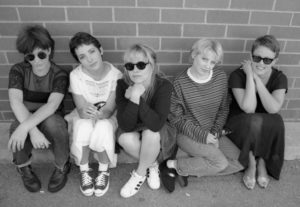
Credit: Vicki Berndt
HK: I really liked the incorporation of animation in your Go-Go’s documentary. It moved the story.
AE: Since it's a story set in the late ‘70s, early ‘80s, we wanted the film to have that feel, which is very colorful, rich and a little campy at times. I love the animation we did, which features brilliant, bright, neon colors. Rather than shooting inserts of pushing a cassette into a player, we decided to recreate and animate it to look really vibrant and alive. And thankfully the band all showed up for their interviews with fairly bold colors and outfits. So that helped too.
Some of the footage from back then is rough looking because a lot of it was videotape. Early videotape doesn't hold up all that well. But we just went with it and made it part of the aesthetic.”
It was fun. Initially we cut those sequences that ended up being animated we cut them with archival footage. And then I said at one point it would be really cool if we animated this. It would be a little more fun and more in their heads like if they were imagining these things happening. Because we used it in very specific places for very personal moments and things that were happening to them. And then we had footage from the eighties which was unfortunately kind of crappy video tape that doesn’t hold up that well over time.
So we kind of embraced that quality of it and the bright colors of the eighties, and the scratchy neon-type stuff and started playing with it and I got an old dear friend of mine, Ben Fine, who I’d work with before and started giving him these sequences and he would do these sketches and “that’s exactly what we want to do.”
With a band, you have a group of people who obviously fuel and feed each other, but also take from one another in the creative process. There's a sense of lightning in a bottle that’s hard to capture and these women managed to do it. But it's very volatile, especially with five very strong-willed personalities. And so there can be conflict too, which makes for a much more interesting story.
In so many ways, I think the film is really a story about friendship, love and family. But there's pain in all those relationships, no matter how close they are. They experienced it very meaningfully – and wrote about it.
I've done some rock docs in the past and I think that their genuine honesty surprised me a little bit. Because I think people tend to be very guarded and they really let their guard down with me. The thing I found the most fun to discover was just how wonderful their senses of humor are. They are wickedly smart and funny women who can really banter. They can finish each other's thoughts. There is something truly magical when they're in the room together.
To see that was really exciting because you don't feel that with every band. When you're in the room with the Go-Go's, though, you're in the room with the Go-Go's!
My taste in general is very eclectic. My take on any film is, as long as I'm learning something and enjoying it, it's a great experience. In that respect, THE GO-GO’S was one of the best experiences I've had making a film. It was truly fun to work on.
I feel like I've become friends with them. Even though we haven't spent that much time together, we do correspond and stay in touch. I get their banter and feel like I can jump in sometimes, which is really fun.
HK: In your stellar Women of Troy HBO documentary you employed a lot of wide shots because it was about the USC basketball team. And you had to show us the court floor and the movement of the basketball.
AE: In that I used wide shots quite often because the courts were so impressive. We wanted to feel the space around them and that they were these stars in this big space. So I used wider angles more frequently there. But generally, that middle medium close up is pretty intimate. You can really see people’s expressions and the slightest little facial expressions and even eyes you can see sometimes what they are thinking when they are talking.
HK: I loved your Women of Troy film. You were able to make a basketball-centric movie but it was so much more than hoop. Doris Duke was an incredible interview and her sensitivity and empathy about the basketball pioneers before her was heartbreaking. The McGee twins were wonderful and Cynthia Cooper’s journey. Cheryl Miller delivered. Nancy Leiberman. I know the impact they had on the current players like Diana Taurisi.
I saw the Troy teams play decades ago. Maybe it also connected with me on a neighborhood level because most of the first decade of my life was like a mile or two from the USC campus. I went to Coliseum Street Elementary School in downtown Los Angeles. The team earned two NCAA rings and members won Olympic medals. Your film stresses the sad reality that product endorsement deals and equal pay job opportunities were rare and scarce for female athletes. I knew and worked with UCLA basketball coach John R. Wooden. He always pointed us to the growing and evolving women’s basketball game.
AE: The Women of Troy actually came to me from the producer Gary Cohen who had done a bunch of 30 For 30 sports documentaries. And I like sports, I’m fairly athletic, but never been involved in professional sports. I don’t really know the positions of basketball players. (laughs). I like watching the game but what I love are stories. Good stories. And that’s where I’m always coming from as a filmmaker, always telling the story. And the sport is secondary. Or in some cases, it’s the propulsion of a story but it’s not the story. The story is what is happening to the people. And the McGee twins I was cracking up through that interview half the time. (laughs).
HK: When you are an athlete on a college scholarship, you are not in Hollywood like the Go-Go’s in the eighties or the Eagles in the seventies shall we say “partying.” You are in college and your body is important for daily and demanding physical competition. Do you think The Women of Troy subjects were more honest or direct than the musicians you have interviewed?
AE: That’s an interesting question. Certainly it felt like they were less guarded at the time. I think Cheryl was more guarded. I mean the whole equal pay for equal play is huge and really feels like it is getting momentum going. And I think the women that were in The Women Of Troy film really wanted to tell their story so that it could help push that agenda and get more women playing. I think that is part of it.
I mean when I interviewed the McGee twins right before the interview I was told that in their personal lives they hadn’t spoken to one another in like a year. So, I was nervous about what was gonna happen. And they just went back to how I guess they have always been with one another.
Doris Duke was an amazing interview. She really knew her stuff and told stories so visually along her sense of history. I knew at the time during the edit we had gotten something special from Doris. She was a rock star. (laughs). I do get asked about the film but COVID hit and the same with Laurel Canyon, too. That was the saddest thing about Laurel Canyon. We never got to experience seeing that film with an audience. It was scheduled for SWSW and that festival got cancelled.
HK: I don’t own any albums by the Eagles. But I viewed your documentary on them. Can we discuss this project?
AE: On that one, [manager] Irving Azoff had approached Alex Gibney at Jigsaw to direct that but Alex’s plate was full and he said “I have someone else who would be perfect.” And he threw my name in the hat and I had a few conversations with them.
Again, I was a fan of the music. I genuinely love the Eagles’ music. And then we were off. Alex was a little bit more involved with that one. He was there for most of the interviews with Don [Henley] and Glenn [Fry]. We told them we’re not going to make a commercial. If that is what you guys want then we are not the right people to do it. You guys have to be honest and again we will tell a real honest story here and you are going to have to reach deep.
And what was interesting was that when we had the first rough cut that we were going to show the band, in other words, we were happy with it and it was pretty much to the right length, so we first showed it to Don and Glenn and they had a couple of relative minor things, and we were easily able to adjust, and then we showed it to Joe Walsh. And Joe saw the film and said, “I didn’t know they were going to be that honest. I want to do another interview. I’ve got more to say.” So we did a second interview with Joe and used and mixed both of them. But again they were honest.
HK: Laurel Canyon: A Place In Time. Still photographers Henry Diltz and Nurit Wilde were at the epicenter of your terrific movie. So often the photographers are glimpsed in documentaries, their images and catalog licensed, but you showcased them as spirit guides.
AE: Going into Laurel Canyon one thing that I was concerned about was that I did not want it to feel like an anthology where we are going from one band to another band and this happened and that happened. We really wanted to find organic connections. And I guess that is the one thing that hopefully translates to everything that I do. But you find ways from editing to narration writing that you are making connections that feel organic that don’t feel forced or just walking through chronology.
From the start there was a decision to do audio-only. I made Henry and Nurit guides of the documentary and their interviews are on camera.
So finding those little magical things that you might not even think anything of at the time and yet they end up being an important part of the film. It is finding the moments that are interesting and feel organic and unexpected. I certainly have a role in the music that we choose to put into the cut at any given time. Whether we can clear it or not is another issue. (laughs).
HK: What did you come away with after finishing Laurel Canyon: A Place In Time and THE GO-GO’s film? I know you love the music of Laurel Canyon and always a fan of the Doors. Jim Morrison’s American Prayer is one of your favorite albums.
AE: I think the answer would be the same for both films and also be the answer for the Ken Kesey movie. In that we were able to capture a moment in time that could never be recreated that was formed like some sort of alchemy occurred. And that these people came together and bounced off of one another and created these scenes.
The Go-Go’s with this punk scene in Los Angeles and Laurel Canyon and that whole scene there and how all those artists interacted with one another and influenced one another. And what they learned from one another and what they took from one another. And same with the Ken Kesey piece. That was just this moment in time you could never recreate.
I mean, there is never gonna be another school bus painted with crazy colors with a bunch of acid tripping hippie freaks driving across the country. (laughs). It would never happen again. And to really have had the honor of bringing that moment to life in all three of those films it feels very special.
HK: What is the difference between shooting on video and film?
AE: Being able to shoot documentaries fully in 16mm these days is almost unheard of. It is just so expensive. We did shoot a lot of Super 8 mm in Laurel Canyon. And I’m a big fan of doing that. Especially when the home footage being done has that Super 8 feel in some cases was Super 8. You know we were mixing up things so that in some cases we shot it or some of the artists shot it. So that was super fun to work with that. And the advantages of video now are obviously affordable and you can see what you have right away and you can do it again which is helpful. But I do miss the look of 16mm. It’s just so rich. I haven’t shot an entire film in 16 mm in years.
HK: There has been a renaissance in music documentaries. I know there are more exhibition venues now for viewing, like Netflix, downloading platforms and other sites for music and film. Do you have any theory or an observation why music-driven documentaries are more popular now and acquiring wider distribution?
AE: It’s definitely changed. I think a lot of it honestly has to do with the fact that some of these artists are getting older and they want to tell their own stories and they realize that they should do it while they are around to do it versus leaving it in the hands of others. So that is a big part of it. And it helps that the record labels are now more actively involved with producers. It’s still very difficult to sell and raise money for music documentaries. They are very expensive.
The rates are much higher than they were even ten years ago, which is great because the artists need to get paid which means the budgets have to be higher which makes it harder to sell.
A small portion of this story first appeared in the January/February 2021 issue of Record Collector News magazine.
During 2020 Harvey Kubernik served as a Consultant on the 2-part documentary Laurel Canyon: A Place in Time directed by Alison Ellwood. Kubernik is currently working on a documentary about Rock and Roll Hall of Fame member singer/songwriter Del Shannon.
Harvey served as Consulting Producer on the 2010 singer-songwriter documentary, Troubadours directed by Morgan Neville. The film was shown at the 2011 Sundance Film Festival in the documentary category. In March 2011, PBS-TV broadcast the movie in their American Masters series.
Kubernik was a talking head in director Matthew O’Casey’s 2012 Queen at 4 documentary broadcast on BBC Television and released as a DVD Queen: Days Of Our Lives in 2014 via Eagle Rock Entertainment.
Harvey was also spotlighted for the 2013 BBC-TV documentary Bobby Womack Across 110th Street, directed by James Meycock. Womack, Ronnie Wood of the Rolling Stones, Damon Albarn of Blur, the Gorillaz and Antonio Vargas are featured.
In 2019 Harvey Kubernik appeared as an interview subject in the Chris Sibley & David Tourje-directed short documentary entitled John Van Hamersveld: Crazy World Ain’t It. Van Hamersveld designed the iconic Endless Summer visual image and album covers for the Beatles, the Rolling Stones, Jefferson Airplane, Grateful Dead, the Beach Boys, the Kaleidoscope, and Blondie.
In summer of 2019, Harvey was a screen interview for director Matt O’Casey on his BBC4-TV digital arts channel Christine McVie, Fleetwood Mac’s Songbird. The cast includes Christine McVie, Stan Webb of Chicken Shack, Mick Fleetwood, Stevie Nicks, John McVie, Christine’s family members, Heart’s Nancy Wilson, Mike Campbell, Neil Finn, and producer Richard Dashut. Debut broadcast was in September 2020.
Kubernik recently sat for an interview with director Neil Norman for the GNP Crescendo documentary, The Seeds: Pushin’ Too Hard along with Bruce Johnston of the Beach Boys, Iggy Pop, Kim Fowley, the Bangles and Johnny Echols of Love. During 2021 it’s scheduled to premiere in retail platforms.
This decade Harvey was filmed for the in-progress music documentary about the former Hollywood landmark Gold Star Recording Studio and co-owner/engineer Stan Ross, produced and directed by Brad Ross and Jonathan Rosenberg, in which Brian Wilson, Herb Alpert, Richie Furay, Darlene Love, Mike Curb, Chris Montez, Nino Tempo, Bill Medley, Don Randi, Hal Blaine, Don Peake, Charles Wright, Johnny Echols, Gloria Jones, Carol Kaye, Marky Ramone, Artie Butler, David Kessel and Steven Van Zandt were lensed.
In 1979 the Go-Go’s band recorded their 5-song demo tape at Gold Star.
During 2020 Harvey’s 19th book, Docs That Rock, Music That Matters was published, featuring interviews with D.A. Pennebaker, Chris Hegedus, Albert Maysles, Murray Lerner, Morgan Neville, Dr. James Cushing, Curtis Hanson, Michael Lindsay-Hogg, Andrew Loog Oldham, Dick Clark, Ray Manzarek, John Densmore, Robby Krieger, Travis Pike, Allan Arkush, and David Leaf, among others.
This century Kubernik wrote the liner note booklets to the CD re-releases of Carole King’s Tapestry, Allen Ginsberg’s Kaddish, Elvis Presley The ’68 Comeback Special and The Ramones’ End of the Century).
In November 2006, Harvey Kubernik was a speaker discussing audiotape preservation and archiving at special hearings called by The Library of Congress and held in Hollywood, California.

